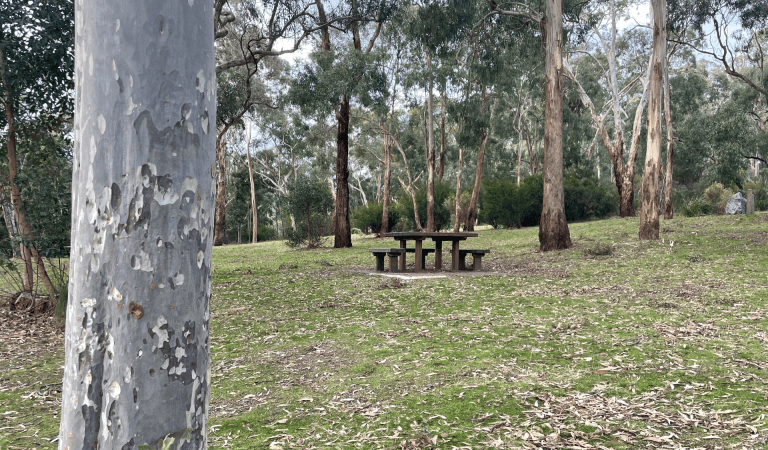Explore
Churchill National Park
Consisting of woodland and small areas of original forest, Churchill National Park is home to a large Eastern grey kangaroo and Swamp wallaby population. The park is a wonderful display of the original landscape before clearing and settlement.
With an abundance of peaceful walking tracks, as well as many jogging and riding tracks, you will likely spot some native wildlife as you venture through the park. Make your way up Stonemasons Track to the Trig Point Lookout to experience 360-degree views of the park.
As you wander through the many trails, ensure you have your binoculars onboard. Carefully observe the different layers of canopy, spying reptiles basking in the sunlight, macropods moving through the shrubs or spotting a Powerful owl roosting in overhanging branches.
Look carefully and you might spot an array of parrots, honeyeaters, Superb Fairy-wrens, thornbills, grebes, pelicans, cockatoos or even the migratory Japanese Snipe and Swift Parrot. With Peregrine Falcons and Black-shouldered kites nesting in the area, birdwatchers won't be disappointed with the biodiversity in the sky. Keep an eye on the Birdlife Australia website, who records any major sightings of endangered species such as the migratory Swift Parrot.
Many other species of fauna reside in Churchill National Park. Some species include a healthy population of Powerful owls, Little Forest bats and numerous species of frogs, reptiles and snakes. The endangered Southern Toadlet can be heard croaking from the network of creeks throughout the park.
Over a dozen different eucalypt species, wattles and native orchids can be seen within Churchill National Park. You might notice large tussocks with long leaves - these plants are known as Red-fruit Saw-sedge. These plants, which can be found in the damp woodlands, are vital for the survival of the Sword Grass-brown butterfly. They lay their eggs exclusively on the Saw-sedge, and the plant plays an essential part in their life cycle.
Things To Do

Walking

Picnics

Birdwatching
Guided Park Walks
Churchill National Park
This area is well known for its wildlife. Keep an eye out for:
Tours and adventure experiences in parks
One of the best ways you can get into nature is with a Licensed Tour Operator.
There are more than 400 Licensed Tour Operators across Victoria who are ready and waiting to help you experience and connect with Victoria’s spectacular parks and waterways.
Discover more than 60 different types of nature-based experiences including hiking, mountain biking, boating, four-wheel driving, indigenous culture tours, birdwatching, surfing, diving and so much more.
Licensed Tour Operators know all the best places to go and will plan and prepare your visit to ensure you are safe and can enjoy your nature-based adventure to the fullest.
How to get there
Churchill National Park
Access to Churchill National Park’s main entrance is from Churchill Park Drive, in Lysterfield South.
When you're there
Download the Lysterfield Park and Churchill National Park visitor guide for more information about the park and a map.
Please note: dogs are not permitted in either Churchill National Park or Lysterfield Park.
Need to know
Churchill National Park
Accessibility
Visiting a park can be more of a challenge for people with disabilities, however in Victoria there are a wide range of facilities to help people of all abilities enjoy our wonderful parks around the state.
Assistance dogs are welcome in Parks Victoria parks and reserves. Entry requirements apply for parks and reserves that are usually dog prohibited, such as national parks.
Change of Conditions
Nature being nature, sometimes conditions can change at short notice. It’s a good idea to check this page ahead of your visit for any updates.
-
Churchill Picnic Area (Churchill National Park)
Toilet Facility Closed
The toilet facility is currently closed due to critical septic system failure making it unsafe for continued operation.Alternate toilet facilities are available at Hallam North Rd, Lysterfield Park entry. -
Notices Affecting Multiple Sites
Notification of Fox Control Program
Parks Victoria are undertaking fox control in Lysterfield Park, Churchill National Park and Baluk Willam Nature Conservation Reserve to relieve predation of vulnerable and threatened native fauna and minimise impacts on neighbouring farm values.The program involves the use of Canid Pest Ejectors with para-aminopropiophenone (PAPP) poison, cage and soft-jaw leghold traps to reduce fox numbers in strategic locations.Domestic animals (dogs and cats) are prohibited from entering all park areas and may be at risk if they do so.Fox control will occur until June 2026. For more information about the program please visit this link or call 13 19 63.Please see the attached map of the control area.Attachments: Control Area (LP, CNP, BWNCR) (619KB)
How we keep it special
We aim to ensure that our valued parks, and the natural assets and cultural heritage they hold, can be enjoyed now and by future generations.



